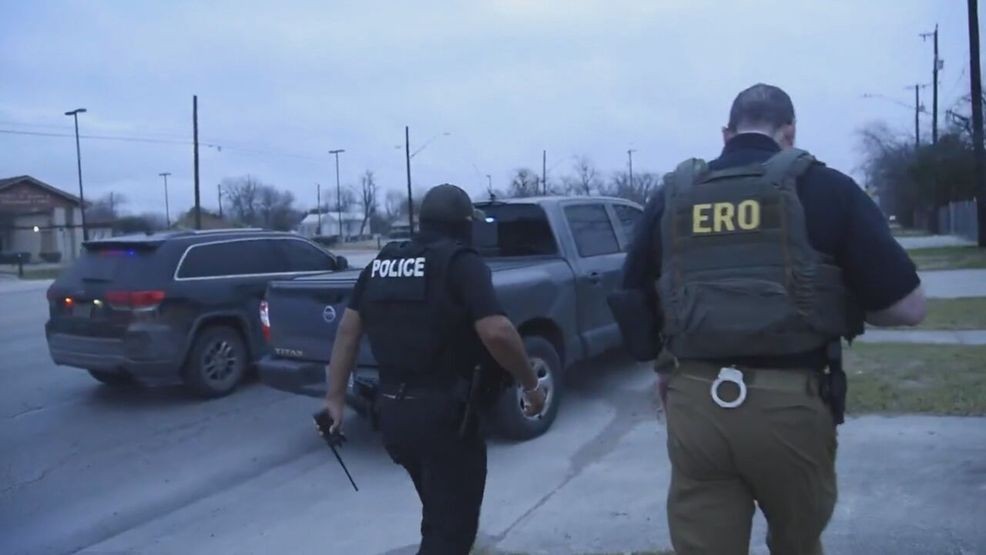TERRELL COUNTY, Texas — For decades, enforcing immigration laws has been the federal government’s responsibility. But soon, most Texas sheriff’s offices will be required to help.
It’s part of a new state law that will force counties that run or contract out operations of a jail to participate in an Immigration and Customs Enforcement (ICE) program called 287(g), named for a section in the Illegal Immigration Reform and Immigrant Responsibility Act of 1996.
But right now, only about a third of Texas counties are signed on.
The program allows them to delegate some immigration duties all the way down to local officers.
According to the agency, the program “enhances the safety and security of our nation’s communities by allowing ICE Enforcement and Removal Operations (ERO) to partner with state and local law enforcement agencies to identify and remove criminal aliens who are amenable to removal from the U.S.”
We went through federal documents to show you which counties are — and are not — on board.
The program lets law enforcement agencies take part in immigration enforcement, using one of three models.
- Under the task force model, officers can use enforcement power in routine work or while assisting an ICE-led task force.
- The warrant service officer program allows local officers to serve and execute administrative warrants on migrants in local custody.
- The jail enforcement model focuses on identifying and processing people eligible for removal who are already in county jails.
On the border, where sheriffs are arguably more likely to encounter undocumented migrants, Terrell is one of only two counties with a 287(g) agreement.
We toured an abandoned ranch along Highway 90 in Terrell County with Sheriff Thaddeus Cleveland. He says it’s an example of why these agreements are important.
“Walk around this way,” Cleveland said, leading us around the side of a house to a small opening in the wall. It led to a short compartment underneath the home.
It’s full of camouflage backpacks, stashed by groups of people smuggled into the U.S., stashed there as migrants finish one journey and start another.
“They’d been using this area for quite a while,” Cleveland says. “No telling how many hundreds, if not thousands of people came through this area to get picked up on the highway.”
Cleveland says discoveries like this are part of the reason why Terrell County was quick to join the 287(g) program through Immigration and Customs Enforcement.
“I see it as an extra tool in the toolbelt,” Cleveland said.
Terrell County is signed up for all three models, but Cleveland says the jail enforcement model will likely be the easiest option for counties to sign up for.
“It will allow us to identify them and then either turn them over to Border Patrol or ICE when they’ve served their time,” he added.
Clint McDonald leads the Texas Border Sheriffs Coalition. He gave us more insight into why so few border counties are currently participating.
“They don’t have to put the man-hours into 287(g). They can just call them and they’ll be at their jail anytime they need them,” McDonald said, of ICE and ERO agents.
McDonald says that just because counties aren’t signed up doesn’t mean they aren’t working with ICE. Many simply lack the manpower to send deputies to training and then remove them from patrol to work with ICE.
But some of the required trainings have moved online, meaning deputies don’t have to travel to learn those processes.
“They’ve made it a lot easier for the counties. And so with that, I think you’ll see more counties getting involved,” McDonald said.
Especially because most counties will have to participate.
“The state of Texas has passed a bill that will require all sheriff’s offices in the state of Texas to work with ICE under that agreement,” Cleveland said, explaining that agencies will still be able to choose which of the three models to use.
The bill signed by Gov. Abbott requires sheriffs who run a jail or contract out jai operations to enter a 287(g) agreement, which applies to 234 of the state’s 254 counties, according to a bill author.
Bexar County Sheriff Javier Salazar says his office will follow the law, but the district attorney’s office is looking into what that will mean locally.
“The warrant service officer model seems to be the one that I would prefer if given the choice between those three,” Salazar said.
He noted that it requires shorter online training and would allow deputies to remain in the community.
“It’s actually not much different than what’s already occurring and what’s been occurring,” Salazar said.
Opponents of the new law worry it will increase racial profiling, stretch departments too thin, or create liability for taxpayers. Supporters argue it will help local agencies assist federal immigration enforcement.
The Texas law requiring some sheriff’s offices to participate in the ICE program goes into effect in January.
It also comes with some financial assistance for counties, depending on their population size.
- $80,000 for a county with a population under 100,000
- $100,000 for a county with a population between 100,000 and 500,000
- $120,000 for a county with a population between 500,000 and 1 million
- $140,000 for a county with a population over 1 million
According to Texas Policy Research, annual compliance reports are required, and the Attorney General may initiate enforcement actions against sheriffs who fail to comply. The law takes effect on January 1, 2026, with compliance required by December 1, 2026.
